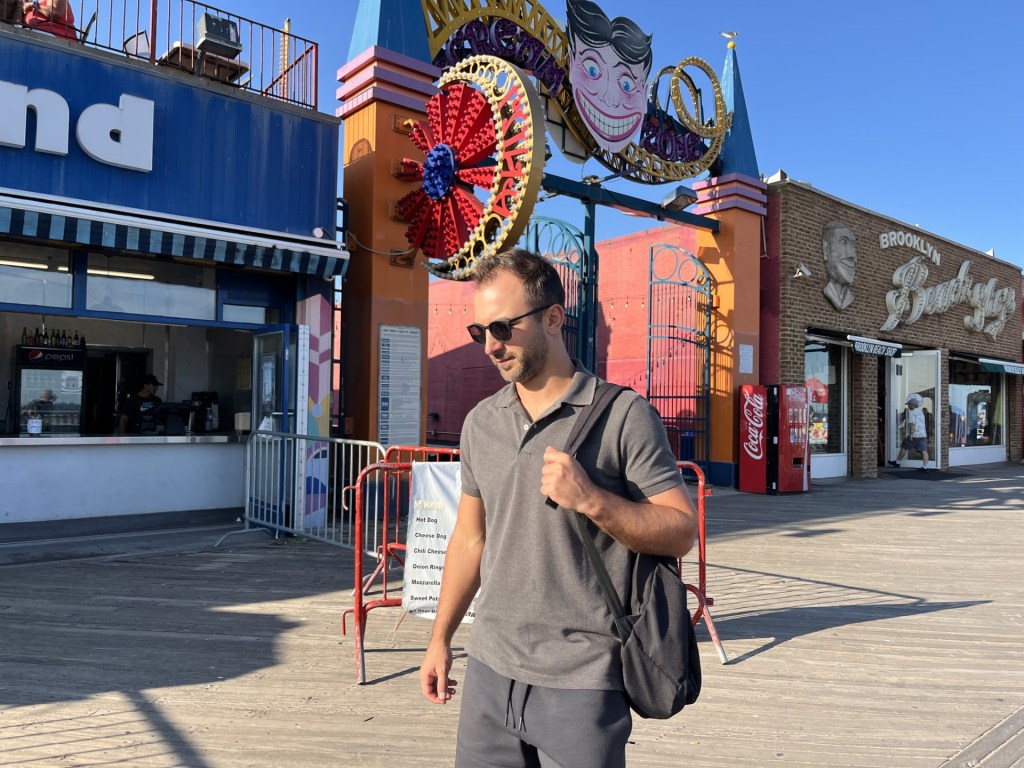This spring, not long after the second inauguration of Donald Trump, Irina Khorinas saw her hopes for a new life in the United States collapse.
Two years earlier, she and her teenage daughter, Viktoria, had fled the war in Ukraine. They landed in New York, determined to begin again. Irina found a job in sales at a local department store in Long Island, while Viktoria enrolled at Farmingdale State College.
“After a year of hearing missiles and drones in the sky, we had finally reached a safer environment,” Irina says.
That sense of safety has vanished.
“We are trapped in uncertainty. Nothing is safe for us now,” said Irina, who lost her work permit. Her daughter’s place in college now hangs by a thread.
Irina and her daughter are among the estimated 40,000 Ukrainians who landed in New York City after fleeing the war in Ukraine. Now, as the Trump administration upends Biden-era refugee and parole policies — and as the President himself meets with Russian President Vladimir Putin and Ukrainian President Volodymyr Zelensky and proposes land swaps to end the war — their plight is more precarious than ever.
The unraveling began in January 2025, when the new U.S. administration announced it was suspending refugee programs to new applicants — including the one that had granted Ukrainians a two-year stay in the United States along with work authorization. Soon after, United States Citizenship and Immigration Services (USCIS) abruptly halted the processing of renewals from those already in the country under humanitarian parole, which had been set to last two years and could have been renewed, allowing them to remain in the United States.
The result was swift: thousands of Ukrainians were cast into a bureaucratic no man’s land and now live with the constant dread of deportation. Work permits and education funding tied to parole are stalled, leaving workers like Irina and students like Viktoria with their futures abruptly on hold.
Dmitriy Kernes, another Ukrainian refugee, has been living in Brooklyn since June, after leaving his first refuge in Florida in search of more work, more community ties, and a more secure path to stay. Months later, his humanitarian status and work permit are still pending. He says he has got barely enough left to cover his share of the rent. “I have no idea what I’m going to do next,” he says. “Every day I wake up hoping for a miracle — something like winning the lottery.”
Anne L. Smith, of the Ukraine Immigration Task Force, calls their predicament part of a “a crisis of enormous consequence for Ukrainians.” The nonprofit has been helping those displaced by the war since 2022, when Russia’s full-scale invasion began. Multiple avenues have been affected by the administration’s goal to tighten immigration pathways, Smith explains.
For both of them, a return to Ukraine would mean return to a war zone — and for Dmitriy, returning to his hometown of Luhansk would necessitate returning to territory claimed by Russia.
Dmitriy’s hometown, in Donbass, was declared the Luhansk People’s Republic by Russian-backed paramilitaries in 2014 and has effectively been under occupation for more than a decade. Irina’s hometown, Pavlohrad, lies near the frontlines and has frequently been targeted by attacks from the Russian army.
“We have lived through this before: even if the war freezes, this conflict is not going to end soon” she said.
Both emphasize that since the full-scale invasion, there has been no truly safe place in Ukraine. With legal protections for Ukrainians in the U.S. under assault, June saw the highest number of civilian deaths and injuries in the three-year conflict, with almost no part of the country safe, even far from the frontlines. In July, Ukraine faced ten times more missiles and loitering bombs than in June 2024.
Fragile Stability
The ongoing threat in Ukraine was the reason former President Joe Biden launched the Uniting for Ukraine (U4U) program in 2022 — a streamlined pathway granting Ukrainians humanitarian parole status until it is safe for them to return. Both Irina and her daughter, as well as Dmitriy, like many Ukrainians in New York, arrived under this program.
From the start, however, the program had its limits, says Natalia Travilina, founder of TraNa Relief, a network that supports displaced Ukrainians in New York and New Jersey.
 Ukrainian refugee Dmitriy Kernes has been living in Brooklyn for several months, Aug. 8, 2025. Credit: Mariia Fedorova/THE CITY
Ukrainian refugee Dmitriy Kernes has been living in Brooklyn for several months, Aug. 8, 2025. Credit: Mariia Fedorova/THE CITY
First and foremost, displaced Ukrainians needed a financial sponsor — often a relative — who could commit to supporting a newcomer. “We had lost everything, so I had no other chance than to find a family who could support us through the whole initial period,” she said. “I was clear that I had nothing except my will to build a livelihood and my responsibility for my child.” Through the national initiative Welcome.US, a generous family on Long Island took them in, providing cash, food and a room in their home. With their support, Irina found a sales job, and Viktoria began college.
For Dmitriy, the U4U program was equally crucial. His relatives in Florida sponsored him, and his humanitarian parole status allowed him to apply for public benefits such as food stamps and Medicaid. Initially, he took on a series of odd seasonal jobs — delivery work, storage shifts and hauling supplies at a fast-food chain. “I was prepared mentally for hard times,” he said, “but living it was a whole different experience. It left me drained.”
Now, though, even that fragile stability has fallen apart.
The next step for Irina und Dmitriy was supposed to have been a routine bureaucratic procedure: they applied to renew their humanitarian parole status at the two-year mark, before Trump suspended the program.
In the meantime they also applied for Temporary Protected Status (TPS), a federal program designed for people from countries in crisis — whether war or natural disaster — that grants legal stay and a work permit. Citizens from Venezuela, Haiti and other countries were among those long covered by TPS until Trump revoked their status. Ukraine will remain part of TPS until 2026, with its future uncertain after that.
Like many other Ukrainians, Irina and Dmitriy filed applications for both in an effort to secure their stay. Since then they have heard nothing back from either program.
For many recent arrivals, the situation is even more precarious. Only Ukrainians who reached the U.S. before August 16, 2023, are eligible for TPS. In these uncertain days, circumstances could shift even more rapidly for many displaced Ukrainians.
Case-by-Case Reviews
Ukrainians in the U.S. saw a glimmer of relief in early June, when a federal court lifted the freeze for those who had already arrived under the parole program or had reapplied for re-parole. But by then, the months-long pause had already created a massive backlog.
In response to inquiries from THE CITY, a spokesperson for United States Citizenship and Immigration Services (USCIS) said via email, requests for re-parole would be reviewed on a case-by-case basis. Applicants must demonstrate that urgent humanitarian reasons or significant public benefit justify their continued presence in the United States.
Smith of the Ukraine Immigration Task Force sees this as a deliberate shift in strategy. “This administration seeks to return to individual case-by-case determinations of humanitarian parole, rather than broad programs like we’ve had,” she explained.
The process for re-parole applications is getting more complex, according to Yulia Dolich, senior coordinating paralegal with the New York Legal Assistance Group (NYLAG). “We see that USCIS has started sending request for evidence letters asking individuals to explain their own specific circumstances and provide evidence, instead of describing the war in Ukraine and general conditions in Ukraine as the reasons for re-parole,” claimed Dolich.
‘Self-Deportation’ Encouraged
Now, Irina rarely leaves her newfound home without documents proving her cases are still being processed and that her sponsors are ready to support her financially, in case she is stopped by Immigrations and Customs Enforcement. But these papers offer little real security about what lies ahead.
Dmitriy tried to hold on to hope that with his case pending, he might still be able to work. He has applied for jobs in logistics, restaurants and security services across New York City. Yet every employer turns him away. “They all need an official work permit,” he said.
Many Ukrainians have reported being fired from their jobs, according to Smith. “Many more are being effectively forced to choose between working unlawfully — which can affect all their future immigration goals, get them arrested by immigration enforcement, and even get their employers arrested — or face starvation for themselves and their families,” she said.
Deborah Chen, supervising attorney for NYLAG, said: “I hear from clients every day, who are asking me: How am I going to pay for my rent? How am I gonna pay for my groceries?”
Smith sees the squeeze on Ukrainians as part of a Trump administration policy aimed at encouraging “self-deportation” — leaving the country on their own.
“That’s the stance they’ve expressed repeatedly,” Smith explains — a policy that affects not just Ukrainians, but people of virtually all nationalities whom the administration does not consider to be here lawfully.
But Ukrainians from hard-hit regions are stuck. Natalia Travilina of the volunteer network TraNa Relief puts it plainly: “Many families in our group have essentially nowhere to return to — their homes have been destroyed.”
Irina and her daughter Viktoria understand this all too well. “I would never even try to stay here illegally,” Irina says. “But at the same time, I know I will not return to Ukraine.”
For Dmitriy, returning to Ukraine would also mean the constant danger of missiles and drones — and almost certain deployment to the frontline. “I wish for something very simple: just some security. Some peace of mind in these insane, brutal times” Dmitriy said. “I don’t want to think that tomorrow I might lose my job, my permits might expire and I’ll have no money to pay rent.”
Neither Irina nor Dmitriy has received updates on their applications. Dmitriy’s latest notification says his work permit will be processed in approximately 45 months.
Related
